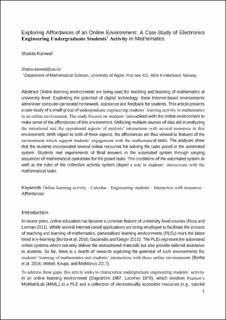| dc.contributor.author | Kanwal, Shaista | |
| dc.date.accessioned | 2020-11-04T14:47:39Z | |
| dc.date.available | 2020-11-04T14:47:39Z | |
| dc.date.created | 2020-10-16T15:47:11Z | |
| dc.date.issued | 2020 | |
| dc.identifier.citation | Kanwal, S. (2020). Dynamics of undergraduate engineering students’ learning activities in mathematics in an online and in a blended environment (Doctoral thesis). University of Agder, Kristiansand. | en_US |
| dc.identifier.isbn | 978-82-7117-993-9 | |
| dc.identifier.issn | 1504-9272 | |
| dc.identifier.uri | https://hdl.handle.net/11250/2686445 | |
| dc.description | Paper IV is not published yet. | en_US |
| dc.description.abstract | This thesis reports from a research study which investigates the role of technology rich environments in undergraduate engineering students’ processes of learning mathematics. The research is founded within a naturalistic research paradigm (Lincoln, 2007) and adopts a case study design (Yin, 2014). The two cases under consideration comprise a small group of undergraduate electronics engineering students, selected as participants, from an online and a blended learning environment (Borba et al., 2016). The first case study of online environment incorporates an online system, MyMathLab, for homework and assessment, and tutorial videos for the lectures in a calculus course. The second case study of blended environment involves group work using paper and pencil and face-to-face lectures instead of tutorial videos in the subsequent course for the same class. The incorporation of digital systems in mathematics, particularly with regard to students’ interactions, has not been researched enough (Borba et al., 2016). Qualitative approaches were adopted to collect and analyse the data, and empirical material was collected through multiple methods including student observations, interviews, field notes, and students’ weekly reports.
The aim of the thesis is to analyse students’ interactions with these environments and to get insights into the factors which play a role in students’ engagement with mathematics. In doing so, the study explores dynamics that underlie students’ learning activities including students’ interactions with available resources, and macro and micro conditions of the learning environment. Cultural historical activity theory (CHAT) was used as an overarching theoretical framework for conceptualising students’ learning activities and for analysing the data. | en_US |
| dc.language.iso | eng | en_US |
| dc.publisher | 07 Media | en_US |
| dc.relation.ispartofseries | Doctoral Dissertations at the University of Agder; no. 291 | |
| dc.relation.haspart | Paper I: Kanwal, S. (2018). Mathematical Competencies and E-Learning: A Case Study of Engineering Students’ Use of Digital Resources. In A. Weinberg, C. Rasmussen, J. Rabin, M. Wawro & S. Brown (Eds.), Proceedings of the 21st Annual Conference on Research in Undergraduate Mathematics Education (p. 1292-1297). SIGMAA. http://sigmaa.maa.org/rume/crume2018/Abstracts_Files/Submissions/40_Mathematical_Competencies_and_E-Learning__A_Case_Study_of_Engineering_Students__Use_of_Digital_Resources.pdf. Peblished version. Full-text is available in AURA as a separate file. | en_US |
| dc.relation.haspart | Paper II: Kanwal, S. (2018). Engineering students’ engagement with resources in an online learning environment. In V. Durand-Guerrier, R. Hochmuth, S. Goodchild & N.M Hogstad (Eds.), Proceedings of the Second Conference of the International Network for Didactic Research in University Mathematics (p. 145-154). University of Agder and INDRUM. https://hal.archives-ouvertes.fr/INDRUM2018. Peblished version. Full-text is available in AURA as a separate file. | en_US |
| dc.relation.haspart | Paper III: Kanwal, S. (2019). Exploring Affordances of an Online Environment: A Case-Study of Electronics Engineering Undergraduate Students’ Activity in Mathematics. International Journal of Research in Undergraduate Mathematics Education, 6, 42-64. doi: https://doi.org10.1007/s40753-019-00100-w. Peblished version. Full-text is available in AURA as a separate file: https://hdl.handle.net/11250/2648454. | en_US |
| dc.relation.haspart | Paper IV: Kanwal, S. (Forthcoming). Undergraduate Engineering Students’ Mathematical Reasoning Processes in paper and pencil and technological environment. Manuscript. Full-text is not available in AURA as a separate file. | en_US |
| dc.title | Dynamics of undergraduate engineering students’ learning activities in mathematics in an online and in a blended environment | en_US |
| dc.type | Doctoral thesis | en_US |
| dc.description.version | publishedVersion | en_US |
| dc.rights.holder | © 2020 Shaista Kanwal | en_US |
| dc.subject.nsi | VDP::Matematikk og Naturvitenskap: 400::Matematikk: 410 | en_US |
| dc.source.pagenumber | 199 | en_US |
| dc.source.issue | 291 | en_US |
| dc.identifier.cristin | 1840235 | |




